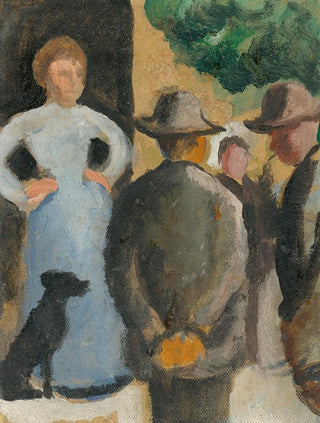Art print | People in the Street - August Macke


View from behind

Frame (optional)
In the hustle and bustle of urban life, "Les gens dans la rue" by August Macke emerges as a vibrant ode to modernity. This artwork, created in 1913, captures the energy and dynamism of a city scene, where the characters seem to dance to the rhythm of a city in full effervescence. The bright color palette and stylized forms evoke an atmosphere that is both joyful and melancholic, inviting the viewer to immerse themselves in a universe where each figure tells a story. The art print Les gens dans la rue - August Macke allows for rediscovering this masterpiece of Fauvism, an artistic movement that favors personal expression and bold use of colors.
Style and uniqueness of the work
August Macke's work is distinguished by its unique style, blending Fauvist and Expressionist influences. In "Les gens dans la rue," the vivid colors juxtapose with such intensity that they seem to vibrate on the canvas. The characters, with simplified contours and stylized features, are immersed in a world where reality transforms into a subjective representation. Macke manages to capture not only the appearance of the figures but also the very essence of their emotions, making each gaze and gesture imbued with life. Shadows and lights play a crucial role, creating depth that invites exploration. This artwork is a true celebration of modern life, where movement and color combine to evoke a sense of urgency and beauty.
The artist and his influence
August Macke, an emblematic figure of the early 20th century, knew how to mark his era with an innovative approach to art. Member of the Expressionist group "Der Blaue Reiter," he was influenced by artists such as Wassily Kandinsky and Paul Klee, while developing a style that is uniquely his own. Macke always sought to express his emotions through color and light, making each canvas a reflection of his soul. His work, although tragically cut short by his premature death during World War I, left an indelible mark in the art world. His legacy end

Matte finish

View from behind

Frame (optional)
In the hustle and bustle of urban life, "Les gens dans la rue" by August Macke emerges as a vibrant ode to modernity. This artwork, created in 1913, captures the energy and dynamism of a city scene, where the characters seem to dance to the rhythm of a city in full effervescence. The bright color palette and stylized forms evoke an atmosphere that is both joyful and melancholic, inviting the viewer to immerse themselves in a universe where each figure tells a story. The art print Les gens dans la rue - August Macke allows for rediscovering this masterpiece of Fauvism, an artistic movement that favors personal expression and bold use of colors.
Style and uniqueness of the work
August Macke's work is distinguished by its unique style, blending Fauvist and Expressionist influences. In "Les gens dans la rue," the vivid colors juxtapose with such intensity that they seem to vibrate on the canvas. The characters, with simplified contours and stylized features, are immersed in a world where reality transforms into a subjective representation. Macke manages to capture not only the appearance of the figures but also the very essence of their emotions, making each gaze and gesture imbued with life. Shadows and lights play a crucial role, creating depth that invites exploration. This artwork is a true celebration of modern life, where movement and color combine to evoke a sense of urgency and beauty.
The artist and his influence
August Macke, an emblematic figure of the early 20th century, knew how to mark his era with an innovative approach to art. Member of the Expressionist group "Der Blaue Reiter," he was influenced by artists such as Wassily Kandinsky and Paul Klee, while developing a style that is uniquely his own. Macke always sought to express his emotions through color and light, making each canvas a reflection of his soul. His work, although tragically cut short by his premature death during World War I, left an indelible mark in the art world. His legacy end






